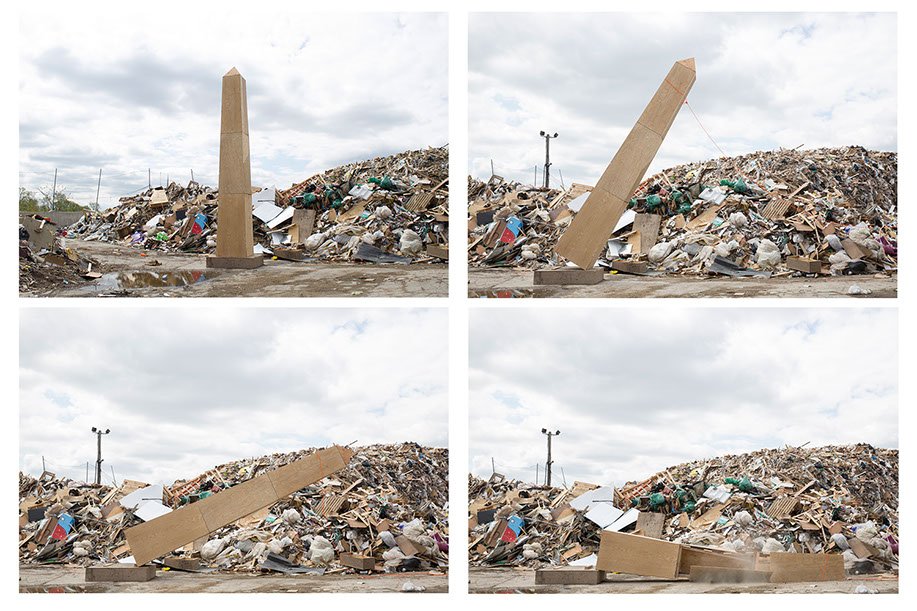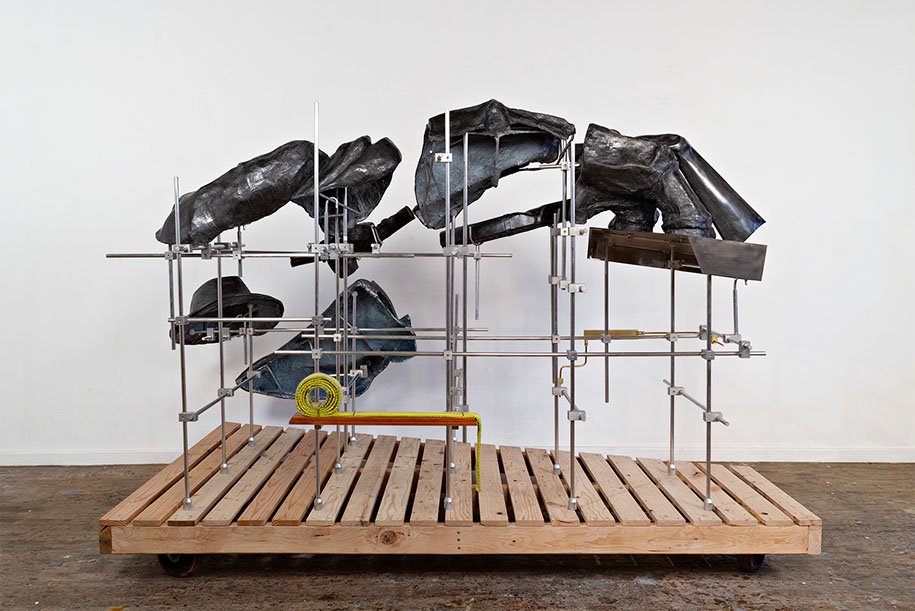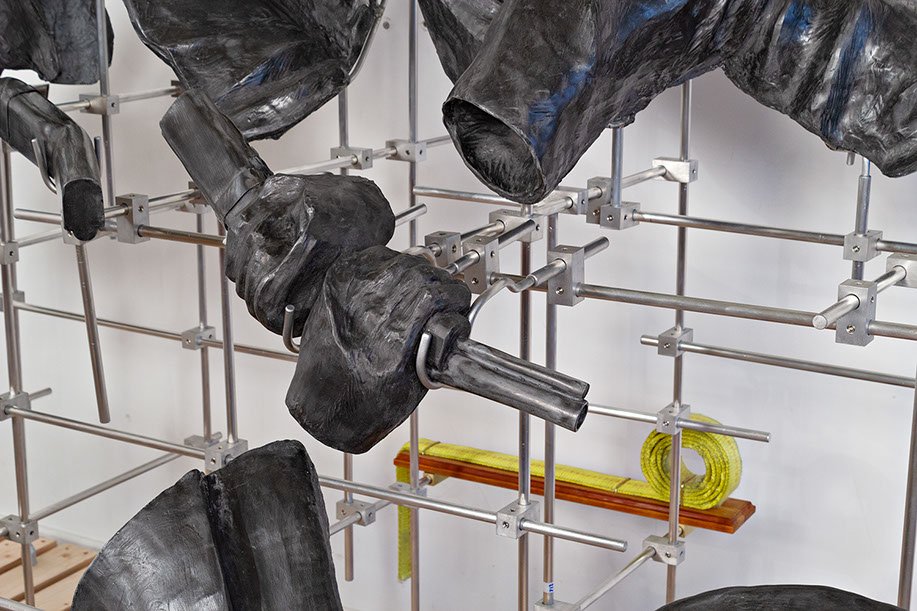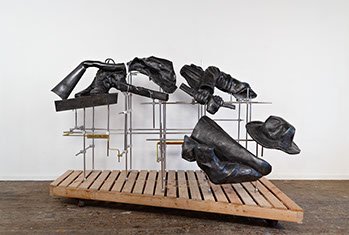“Cleaved interpretation” Antar Kuri on Lewis Colburn
About Lewis Colburn’s Disposable Monument II (After The Boys Who Wore Gray)
“You ask me if there will be a violent revolution in America? Perhaps in 50 years, things will arrive at a crucial point and
these forces that are now underneath will explode.”
M. A. Antonioni interviewed by Guy Flatley
The New York Times, 1970
Suddenly, an entire house explodes. We see it several times and from different angles in a blast of fire and black smoke. With each burst, time slows down and we zoom in on an allegorical exterior place showing the interior of the house where a tv set, a bookshelf, a wardrobe, and a refrigerator each explode in slow motion. A myriad of food and household objects like poultry or a bag of Wonder bread that float in mid-air are captured by Michel Angelo Antonioni’s cinematography against the clear and blue desert sky. (1) The overall effect is that of an exploded view, a device used to gain knowledge of the components of a complex object or construct.
Something akin to Antonioni's almost frozen explosions happens with a recent sculpture by Lewis Colburn. Disposable Monument II (After The Boys Who Wore Gray) from 2021 looks like an exploded statue whose parts are held together in the air by a network of aluminum rods and connectors. It is a sculpture made with polymer-modified gypsum, graphite, and polypropylene to reproduce the look and feel of metal. Presented as a sort of portable installation, it includes a yellow nylon strap, a small dated plaque, and a wood pallet like the ones used for cargo storage. With a straightforward association of the artwork and the name assigned to it, Lewis informs us of an important theme across his artistic practice: the examination of objects with historical relevance.
On August 14, 2017, protestors pulled down a Confederate monument dedicated to “THE BOYS WHO WORE THE GRAY” in front of the historic Durham County Courthouse in Durham, NC. Their protest came in response to the tragic events of the Unite the Right rally in Charlottesville, VA just a few days earlier. The monument comprised a statue made in bronze of an armed soldier in a resting position atop an approximately 10 feet tall granite plinth adorned with the Confederate seal. (2) A group of close to one hundred protesters gathered near the monument. One climbed up to reach the statue and wrapped a long yellow nylon strap around its neck. Then, a dozen more protesters pulled the strap until the statue went tumbling down, twisted by the pull and the impact upon reaching the ground.
Monuments and statues linked to slavery and controversial figures, like the one at Durham, were contested for decades, with more and more being officially removed in the past few years. After George Floyd's death on May 25, 2020, the removal of these monuments sped up as a response to the pressure of massive protests and the Black Lives Matter movement. These incidents started a larger national conversation about the meanings of memory and heritage, prompting related organizations to make public announcements stating their positions on monument removal. (3) This is a topic with paramount importance in an even larger conversation about white supremacy, white privilege, systemic racism, and massive incarceration as a contemporary avatar of persevering slavery.
Lewis’ interest in the historical dimension of objects extends from material integrity all the way to projected ideology. As he expresses it, objects “cannot argue with the narratives we imagine for them”. This might be true for objects other than artworks… or at least one could hope to produce art capable of arguing with us as creators, or hope to encounter an artwork made by someone else that challenges us. History is something that defines us, defines a people and their customs, and defines the objects we surround ourselves with. It accounts for certain events that manifest themselves as physical modifications on the materiality of an object. These modifications arguably create an aura that emanates from the object itself, even if it is a copy. What could one find buried in an auratic mountain of trash?
Disposable monument II already implies a question about permanence, or is it about transcendence? We know our trash will tell our stories in the inquiries of future geologists and anthropologists, but nothing really lasts. Perhaps the question is about mutability or adaptation to change. Can objects adapt to the changes to come? Setting something in stone or setting it in writing seems a weak gesture, and so do ideas of permanence and transcendence once we embrace mutability. The material source for Disposable monument II shows a concern with memory. How can one remain oneself if memory is open to change? A monument, that is a memory set in a material that lasts — or some wish it will last —, is open to change, just like memory itself.
Selective history
Lewis’ noticing of the remains of the statue as a dense object that “seems to encapsulate so much of American history” serves as an ontological example of narrative selectivity shaping objects of collective memory. It is to notice the workings of history not in linear but in twisting and multiple forked paths that go forward and backward, sometimes in unison. This idea of relative historical time, (4) which is a time not fixed but open to interpretation and reframing, is difficult to accept. An idea that causes historians complex problems and unscrupulous politicians opportunities for campaigning. Interpretation and reframing, when used congruously, can be powerful practices to unveil different perspectives on events known as facts. Perhaps an obvious example of this is the main thesis of The 1619 Project that places slavery as a foundational pillar by shifting the starting point in time of the United States as a nation. (5)
In public discourse, too often, one encounters demands to look to the future and cultivate a nostalgia for an idealized past. The problem with this formulation is not the eccentric forces that pull in opposite directions, but the idealization of a past that leaves out the stories of many others. Maybe this is the situation of the monuments dedicated to the Confederacy and the myth of the lost cause. Maybe there is a problem with opposite directions after all, as soon as we consider partisan politics. A polarization of antebellum South versus North that ostracized in the polarization of Republicans versus Democrats in the late 60s, or Conservatives versus 21st century Progressives. Or was it Liberals? And what about Neoconservatism versus Neoliberalism? Are those opposite forces or are they linked by hidden connections in a political backstage? (6)
This is a polarized present for a population deluded by an image of an idealized past that needs to be nurtured and guarded in order not to change. Even a slight discrepancy in that idealization is an attack, for the idealization has become the self of a borderline personality. The proper psychoanalytic term is splitting, commonly known as black and white thinking. (7) More to the point, this is a condition that springs from a polarized worldview that fragments everything in plain sight in order to simplify and reduce an inherent complex reality where ambiguity proliferates. A first step in healing such a condition is to recognize that reality is being split, then to focus on the manner the fragments are apart, looking for a way to connect them. Thus, finally learning how to reconstitute complexity and cope with ambiguity. (8)
A useful split
“It is the explosion of nothing, in fact, it is the spacing of meaning, spacing as meaning and circulation”
J.L.Nancy. Being Singular Plural
In a similar way to that of the psychoanalytic intervention aforementioned, Lewis’ sculpture shows us a reality being split, by him, after being twisted by someone else, the protesters, following its being forged yet by some others, the sponsors. (9) And also like that clinical intervention, Lewis is striving to show us that change is possible. By resorting to the exploded view to deconstruct the object he joins fellow contemporary artists also interested in the spacing of constitutive elements (10) and distances by a notch from the conclusions reached by the committee, appointed by Durham County to resolve the incident and dictate a course of action in the matter of monument removal and conservation. In effect, officials following the committee recommendation stored the statue as left by the protestors, along with the yellow strap and the companion artifacts — cannonballs and light posts. (11) And it was also officials who removed the base 3 years past the event on August 11, 2020, after being continually graffitied with protest claims.
It was James E. Young who said that “only an unfinished memorial process can guarantee the life of memory” when talking about the Memorial to the Murdered Jews of Europe, for which he was part of the selection committee. (12) Here, once more, we are compelled to ponder on the mutable and the incomplete as indicators of something hidden or working backstage, where historians focus on the selection of facts and their interpretation in an endless dialogue between present and past. Moreover, it is here where we find Lewis connecting rods with objects that rest floating, apart from each other, but linked by a prominent network that could be understood as a negative space drawing.
Disposable monument II relates to other works by Lewis not only for his interest in history as a subject. The name reveals a non-declared series of sculptures perhaps started with Disposable Monument, an obelisk constructed with reclaimed plywood and hoisted with the sole purpose of being toppled just a moment after, in a Sisyphean act of apparent contradiction. His use of the word “disposable” seems to hint at the process of paradigm shifts that can be traced throughout the historical record of projected ideologies embedded in objects that are expected to last, like monuments and statues. This too can be observed in another of Lewis' works, A Souvenir of the Minnesota State Fair, 1910 (Butter Roosevelt), where a double negative surfaces with the help of fragmentation or separation of parts of the sculpture: a contemporary negative-reading of a once desired “violent, imperialist white masculinity” — Lewis’ words —, and an ironic conceptual-negative of a sculpture originally made in butter and intended to decompose. For his sculpture, he worked from an old photograph.
Lewis created Disposable monument II for the 2021 Taoyuan International Art Award in Taiwan, where he got an Honorable Mention. This sculpture was devised to travel a long way, sufficient reason it had to tackle two major challenges: a way to travel safely, and a way to be accurately exhibited. As Lewis narrates it, the fragmentation of the sculpture enabled him to “ship it with detailed instructions”. In this light, we can observe a conceptual gesture favoring a practical function, something also noticeable on an exploded view of technical drawing. But perhaps a more apt observation about Lewis’ sculpture is that, with the separation of the constitutive elements and the network that holds them together, it creates a space suited for a conversation about a very needed change.
1) These explosions happen in Antonioni's film Zabriskie Point (1970), after one of the main characters finds out that her companion has been killed by the police. Just a few moments before we see them talking about a college campus demonstration led by black and white students in which a policeman is shot. In their conversation they also evoke “John Brown”, the violent abolitionist credited with starting the Civil War
(2) A full description of this monument can be found in the Commemorative Landscapes of North Carolina website (link accessed: August 24, 2021)
(3) The Society of Architectural Historians support and encourage the removal of Confederate monuments and state that these “do not serve as catalysts for a cleansing public conversation; rather, they express white supremacy and dominance” (link accessed: August 3, 2021). The National Trust for Historic Preservation recognizes both the need to remove the monuments or to keep them in place but with supplemental information “providing a deeper understanding of their message and their purpose” (link accessed: August 10, 2021). The United Daughters of the Confederacy makes the case for keeping the monuments in place, denounces “any individual or group that promotes racial divisiveness” and calls for a decoupling with white supremacism (link accessed: August 1, 2021)
(4) In his 1961 book What is history? E.H. Carr says ”our answer [to the book title], consciously or unconsciously, reflects our own position in time, and forms part of our answer to the broader question of what view we take of the society in which we live”. Carr pictures the course of history as a “moving procession” and continues by saying “as the procession winds along, swerving now to the right and now to the left, and sometimes doubling back on itself, the relative positions of different parts of the procession are constantly changing”
(5) The 1619 Project was published in August 2019 by The New York Times and a team of journalists led by Nikole Hannah-Jones with the purpose to discuss pressing current and historical issues linked to slavery though a series of journalist essays, image galleries, poems and even curricular resources for educators and K-12 students nation width (link). At the same time, Republican conservatives capitalize on the controversial central statement of the 1619 Project — the reframing of the foundational date of the US — and link it to the Critical Race Theory or CRT ban, accusing divisiveness. They present this combo as a “culture war” that needs to be fought, preparing the ground for the presidential elections of 2024 (Jim Banks’ Critical Race Theory Memo link, Steve Bannon quoted saying “This isn’t Q, this is mainstream suburban moms” link, Rusel Vough’s White House memorandum for the heads of Executive Departments and Agencies link, TOOLKIT: Combatting Critical Race Theory In Your Community link)
(6) Wendy Brown's 2006 essay “American nightmare” works on the sighting and description of the similarities, the differences and the synergy between Neoconservatism and Neoliberalism. Brown's goal is pointing out a process of de-democratization because of this synergy. Thinking with Stuart Hall, she explores the idea of dealing with the construct metaphorically as Dreamwork, with the aim to work with overlapping opposites and “discover what might appear as a logical contradiction at the level of ideas to be grasped as partially and unsystematically symbiotic at the level of political subjectivity”
(7) Psychologist Andrew Hartz, Associate Professor of Clinical Psychology at Long Island University (Brooklyn) wrote a piece on the subject for The Wall Street Journal on November 3, 2020 (link accessed: September 2, 2021)
(8) Argentinian psychiatrist José Bleger in his 1967 important work Symbiosis and Ambiguity (first english edition Routledge 2012) develops his ideas about the psychoanalytic work with neurosis and comes up with the term interpretación clivada, that roughly translates to split interpretation, an intervention technique helpful in the identification of the psychotic core — agglutinated nucleus — of the patient (link)
(9) The sponsors are R.F. Webb Camp United Confederate Veterans, Julian S. Carr Chapter United Daughters of the Confederacy, and Citizens of Durham County as stated in the Commemorative Landscapes of North Carolina website (link accessed: August 24, 2021)
(10) M. A. Antonioni makes an exploded view of the emotional state of a grieving character by literally exploding things and filming them in slow motion in Zabriskie Point (1970). Cornelia Parker does something similar, but she explodes a garden shed “Where you store things you cannot quite throw away” and rearranges the remains as a sculptural installation in Cold Dark Matter: An Exploded View (1991). Damian Ortega takes apart a Volkswagen Beetle — an iconic car for a Mexico City inhabitant due to its ubiquity — in Cosmic Thing (2002). A reversible artwork in the sense that one could reassemble the car following a visual relation between the parts
(11) The report assembles detailed information that helps to understand what happened (link). The committee’s recommendation is to include “people, events, and locations missing from Durham’s historical narrative”, for which they provide a list of names (link)
(12) James E. Young was also involved in the selection of the awarded project for New York City's 9/11 Memorial. In an article written for Harvard Design Magazine he contends that “neither the monument nor its meaning is really everlasting. Both a monument and its significance are constructed in particular times and places, contingent on the political, historical, and aesthetic realities of the moment.” Memory and Counter-Memory. The End of the Monument in Germany. Harvard Design Magazine. N.9. Fall 1999 (link)
Lewis Colburn holds a BA instudio art and Russian language from St. Olaf College, and a MFA in sculpture from Syracuse University. Colburn has participated in numerous artist-in-residence programs including Franconia Sculpture Park, SculptureSpace, and RAIR in Philadelphia.Colburn’s work has been shown internationally and throughout the United States, at venues including the Pennsylvania Academy of the Fine Arts, Hallwalls Contemporary Arts Center, the Torrance Art Museum in Los Angeles, the Taoyuan Museum of Fine Arts in Taiwan and Locust Projects in Miami.





